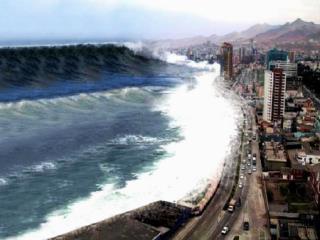Gli articoli di Campanialive.it
Tsunami: A wave of terror (English version)
Autore: Ing. Alberto Fortelli - Redazione Campanialive.it
02/10/2009 (letto 73902 volte)
 (Clicca qui per la versione in italiano)
(Clicca qui per la versione in italiano)
“Tsunami” in japanese means “big waves in ports”. In ports, where normally the sea is smooth or lightly rough also in case of stormy sea, only something really exceptional may generate big waves.
The origins are in the silence of deep oceans, under the sea bottom, where in corrispondence of earth crust submarine tectonic faults, in rocks tends to store huge amount of elastic energy; in corrispondence of these boundary lines, different continental masses press each other, deforming such as any other elastic corp. Step by step, and in proportion, stress increases in value inducing great deformative conditions.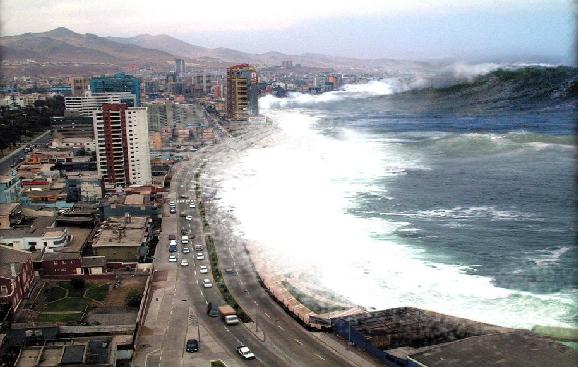 At a moment, the stress reaches so a high value that somewhere, in a sudden way, crisis occurs.
At a moment, the stress reaches so a high value that somewhere, in a sudden way, crisis occurs.
This occurrence create a sudden fall of stress but previously accumulated energy free itself in form of deformation waves that propagates into earth crust (sismical waves), propagating also in sea mass, with different carachteristics depending on invested tectonic structures.
Crisis may consist in a sudden mutual sliding, horizontal or vertical, between two faults (sunk or lift of a portion of sea bottom) or may open a fracture due to traction stress: both this kind of phenomenons induce movement of enormous amount of sea water. The process involved in energy trasferring from rocks to oceanic sea masses is rather complex due to variuos process of fluid mechanics involved. Apart this strictly technical aspects, is possible to say that if sea bottom sunk for a violent earthquake, sea water get suck in the depression from every directions. When sea water collides in the center of depression, due to a inertial phenomenon of sea water masses, they tends to lift like a mountain that then tends to collapse on itself, inducing the centrifugal radial wave generation.
Also a sudden lift of sea bottom induces a phenomenon similar to that of the already described second part.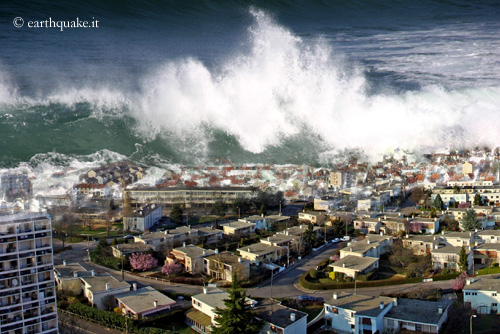 Offshore the waves are usually of very low height: some tens of cm at maximum. A boat may also not realize the passage of a tsunami wave. Very very large is, at the opposite, the wave lenght (wave lenght is the distance between two following crests or two waves cavity): also 100 km, with maximum of 150 km. Another impressive aspect is the speed of propagation of this oscillation waves: in deep seas, where sea is deeper than 1000 metres, the speed may also reach 800 km/h even if, due to the great distance between one crest and the following, may pass also 10 minutes or more. To better understand the exceptionality of what up represented, is sufficient to think that in Mediterranean sea, even in most violent sea storm due to wind, the wave lenght never goes over 150 metres and the period never goes over 15 seconds.
Offshore the waves are usually of very low height: some tens of cm at maximum. A boat may also not realize the passage of a tsunami wave. Very very large is, at the opposite, the wave lenght (wave lenght is the distance between two following crests or two waves cavity): also 100 km, with maximum of 150 km. Another impressive aspect is the speed of propagation of this oscillation waves: in deep seas, where sea is deeper than 1000 metres, the speed may also reach 800 km/h even if, due to the great distance between one crest and the following, may pass also 10 minutes or more. To better understand the exceptionality of what up represented, is sufficient to think that in Mediterranean sea, even in most violent sea storm due to wind, the wave lenght never goes over 150 metres and the period never goes over 15 seconds.
This situation concerns, as said, deep water, where do not exist interference between tsunami waves and sea bottom.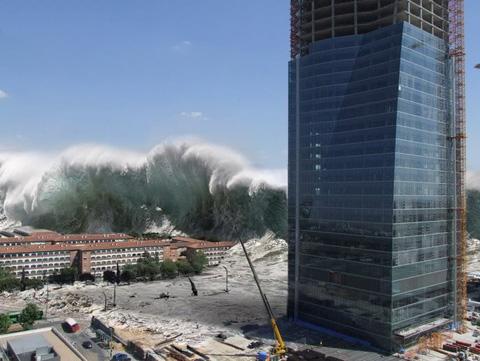 When tsunami waves approach to the coast and begin to interfere with sea depth, it's possible to observe that waves deformate themselves: wave lenght reduces, wave height increases, wave speed decreases. In this phase also begins an energy dissipation but only a very little amount of this goes wasted. At a certain point waves became so ripid that break. Generally, and unfortunately, this happens near the shore so that waves transfer all their huge content of energy on the coast.
When tsunami waves approach to the coast and begin to interfere with sea depth, it's possible to observe that waves deformate themselves: wave lenght reduces, wave height increases, wave speed decreases. In this phase also begins an energy dissipation but only a very little amount of this goes wasted. At a certain point waves became so ripid that break. Generally, and unfortunately, this happens near the shore so that waves transfer all their huge content of energy on the coast.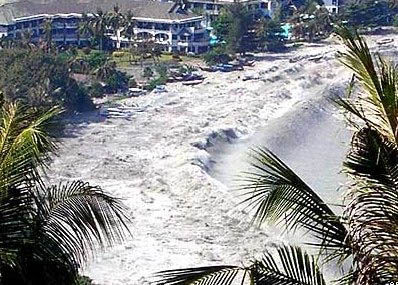 An observer standing on a beach where is arriving tsunami, may observe, at the beginning, water retiring toward open sea, leaving in a dry condition cliffs and low sea beds, as in conseguence of a strong phase of low tide. Then he may observe sea lifting its level and invading the inshore land, in form of enormous waves with a violence that anything can stop; he may observe the arriving of other waves, higher and higher until a trend inversion occur, generally at the fifht or sixth wave.
An observer standing on a beach where is arriving tsunami, may observe, at the beginning, water retiring toward open sea, leaving in a dry condition cliffs and low sea beds, as in conseguence of a strong phase of low tide. Then he may observe sea lifting its level and invading the inshore land, in form of enormous waves with a violence that anything can stop; he may observe the arriving of other waves, higher and higher until a trend inversion occur, generally at the fifht or sixth wave.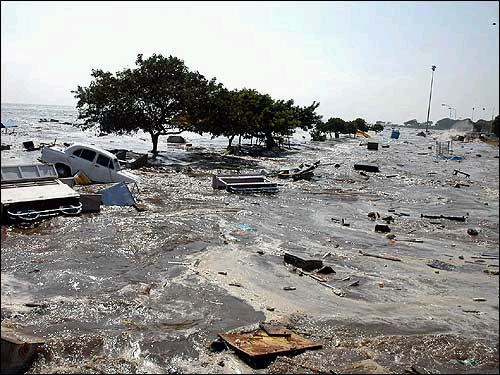 Tsunami waves are oscillation waves and, like every oscillation wave, may present reflexing, refracting o diffracting processes. This feature rends possible the circumstance that an island may be hit by the same tsunami waves from different directions.
Tsunami waves are oscillation waves and, like every oscillation wave, may present reflexing, refracting o diffracting processes. This feature rends possible the circumstance that an island may be hit by the same tsunami waves from different directions.
Pacific islands are at any time under the risk of tsunami waves. Pacific ocean is infact sorrounded from an endless belt of strong sismogenical areas. And we know that earthquakes, expecially if their epicentrum is placed under the oceans, are what generate tsumami.
Many of this islands are atolls, with very low heights on medium sea level: so when a tsunami arrives, the escaping possibility of resident populations are very little. 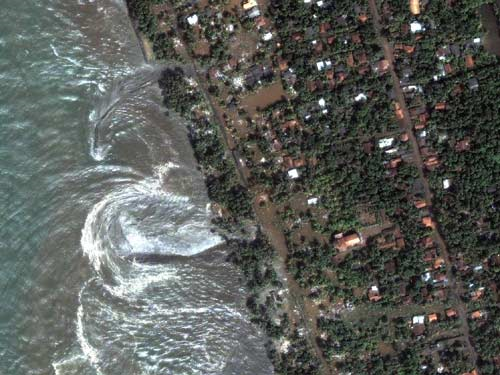 A positive effect of protection is due to the presence of coral reef, circumstance that clearly took place in Hawaii tsunami on 1st april 1946. The larger coral reef of Hawaii Islands, in Kaneohe Bay, is located on northern side of Oahu island. It faced tsunami waves coming from north (the generating earthquake was near Aleutine Islands, about 3000 km north), smoothing waves down to less than half a metre in height. Who lived under the protection of coral reef, had no awareness of what happening not so far away. Some estimation (not validate) reports that major waves height reaching Hawaii was of 15-18 metri (height of a building of 4-5 levels).
A positive effect of protection is due to the presence of coral reef, circumstance that clearly took place in Hawaii tsunami on 1st april 1946. The larger coral reef of Hawaii Islands, in Kaneohe Bay, is located on northern side of Oahu island. It faced tsunami waves coming from north (the generating earthquake was near Aleutine Islands, about 3000 km north), smoothing waves down to less than half a metre in height. Who lived under the protection of coral reef, had no awareness of what happening not so far away. Some estimation (not validate) reports that major waves height reaching Hawaii was of 15-18 metri (height of a building of 4-5 levels).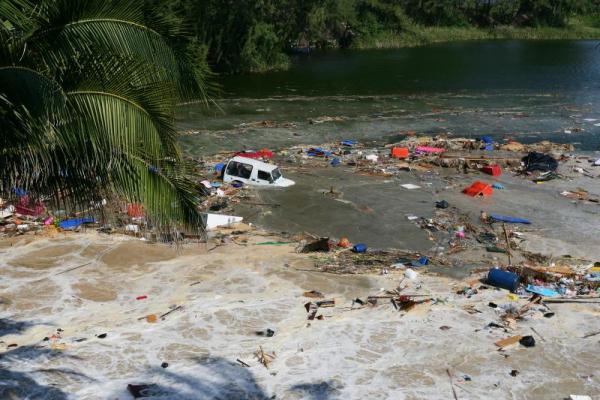 To forecast a tsunami with some day of advance is not possible because of the impossibility in forecasting earthquake that will generate tsunami. But if an eartquake scroll earth crust in a certain geographical area, global sismographic network in a few minutes determines epicentrum and ipocentrum position, and then magnitude of eartquake (richter Scale).
To forecast a tsunami with some day of advance is not possible because of the impossibility in forecasting earthquake that will generate tsunami. But if an eartquake scroll earth crust in a certain geographical area, global sismographic network in a few minutes determines epicentrum and ipocentrum position, and then magnitude of eartquake (richter Scale).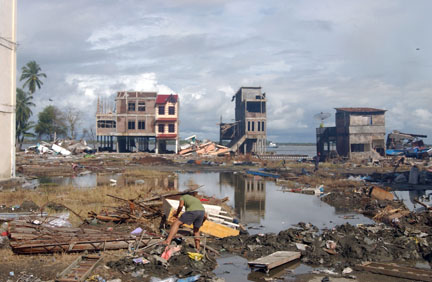 Basing on analisys of this three parameters, in very short time, is possible an evaluation of the risk of tsunami generation; it’s therefore possible allerting every coastal area under tsunami risk. Tsunami waves speed in deep seas is extremely high but is however possible to have a lapse of time to evacuate low coastal areas, areas where tsunami waves can destroy everything. For example, concerning tsunami in Hawaii in 1946, first waves arrived after about 4 hours since heartquake in Aleutina's.
Basing on analisys of this three parameters, in very short time, is possible an evaluation of the risk of tsunami generation; it’s therefore possible allerting every coastal area under tsunami risk. Tsunami waves speed in deep seas is extremely high but is however possible to have a lapse of time to evacuate low coastal areas, areas where tsunami waves can destroy everything. For example, concerning tsunami in Hawaii in 1946, first waves arrived after about 4 hours since heartquake in Aleutina's.
Ing. Alberto Fortelli - Redazione Campanialive.it
Condividi: |
 |
 |
 |








